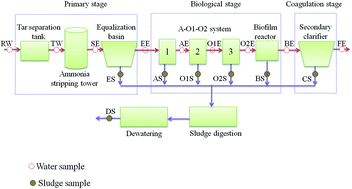Distribution, partition and removal of polycyclic aromatic hydrocarbons (PAHs) during coking wastewater treatment processes†
Abstract
In this study, we report the performance of a full-scale conventional activated sludge (A–O1–O2) treatment in eliminating polycyclic aromatic hydrocarbons (PAHs). Both aqueous and solid phases along with the coking wastewater treatment processes were analyzed for the presence of 18 PAHs. It was found that the target compounds occurred widely in raw coking wastewater, treated effluent and sludge samples. In the coking wastewater treatment system, 4–5 ring PAHs were the dominant compounds, while 4 rings PAHs predominated in the sludge samples. Over 98% of the PAH removal was achieved in the coking wastewater treatment plant (WWTP), with the total concentration of PAHs being 21.3 ± 1.9 μg L−1 in the final effluent. During the coking wastewater treatment processes, the association of the lower molecular weight PAH with suspended solids was generally less than 60%, while the association of higher molecular weight PAHs was greater than 90%. High distribution efficiencies (Kdp and Kds) were found, suggesting that adsorption was the potential removal pathway of PAHs. Finally, the mass balances of PAHs in various stages of the coking WWTP were obtained, and the results indicated that adsorption to sludge was the main removal pathway for PAHs in the coking wastewater treatment processes.


 Please wait while we load your content...
Please wait while we load your content...